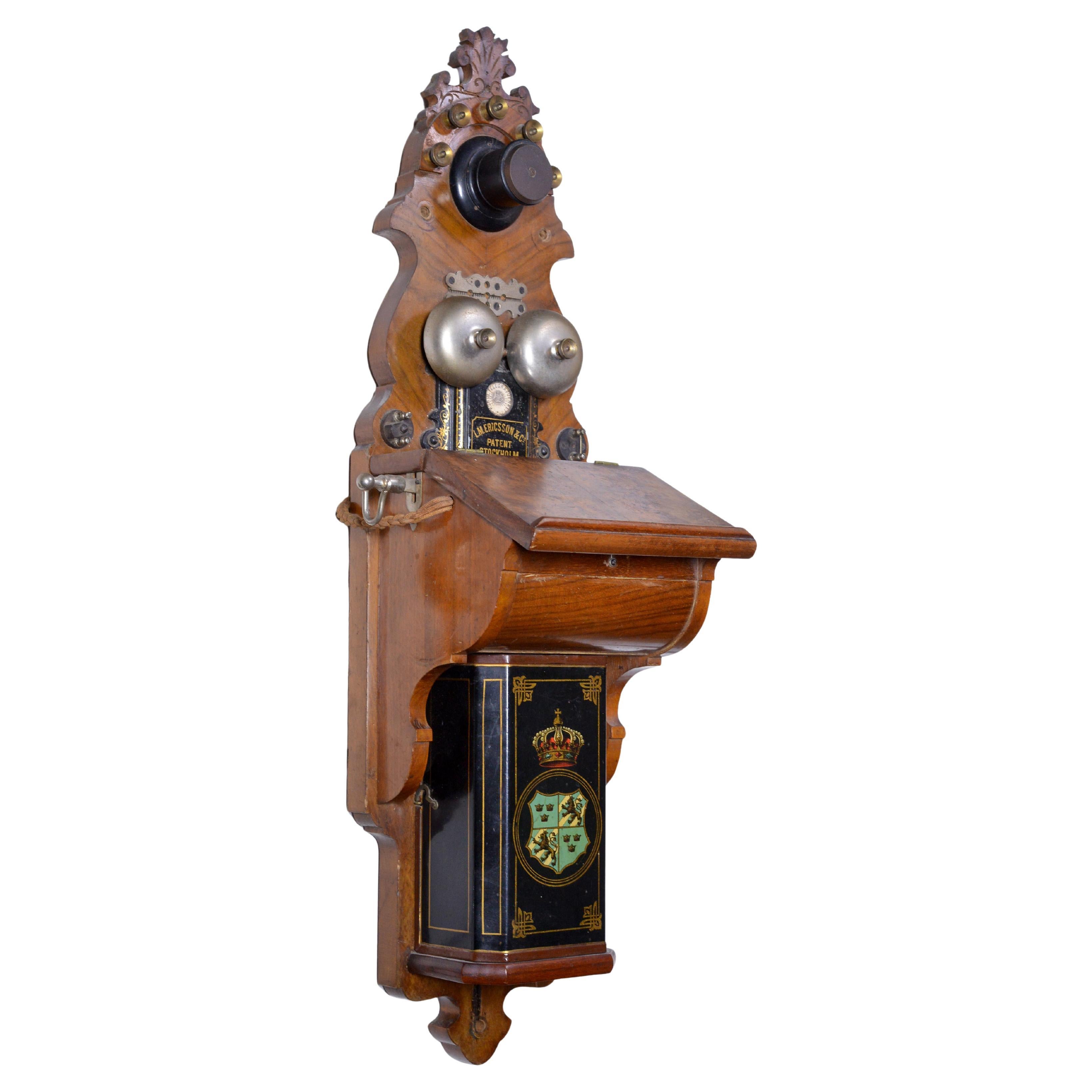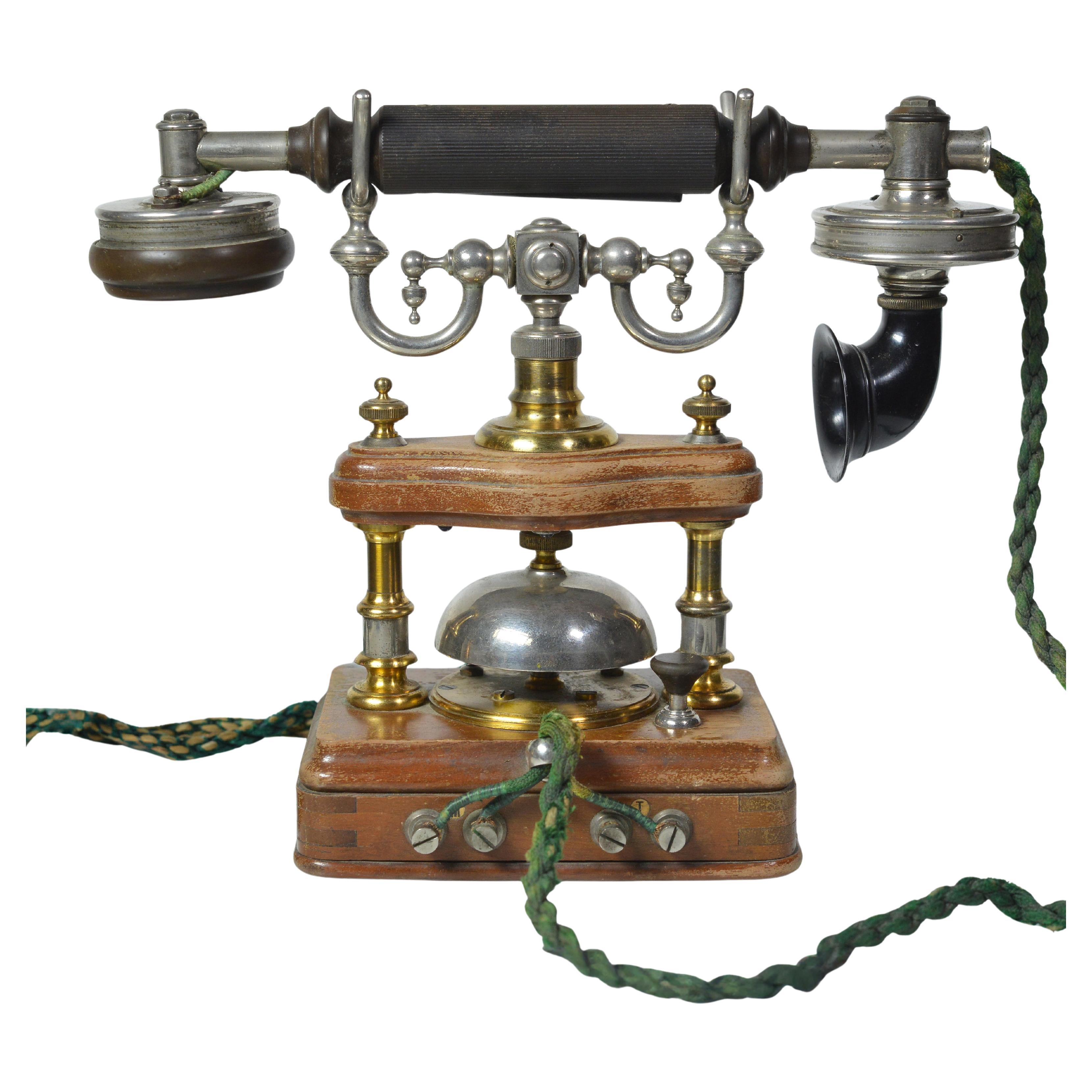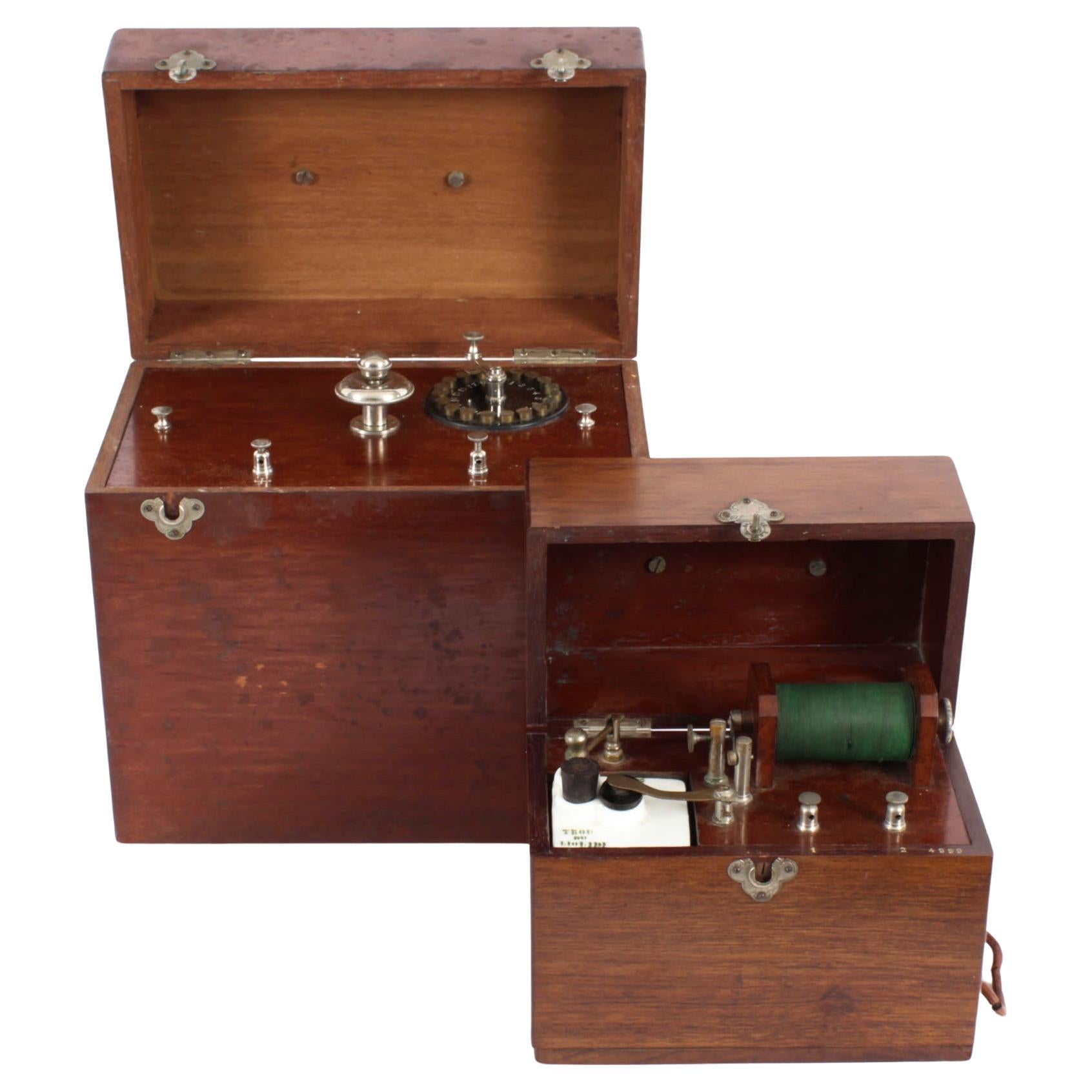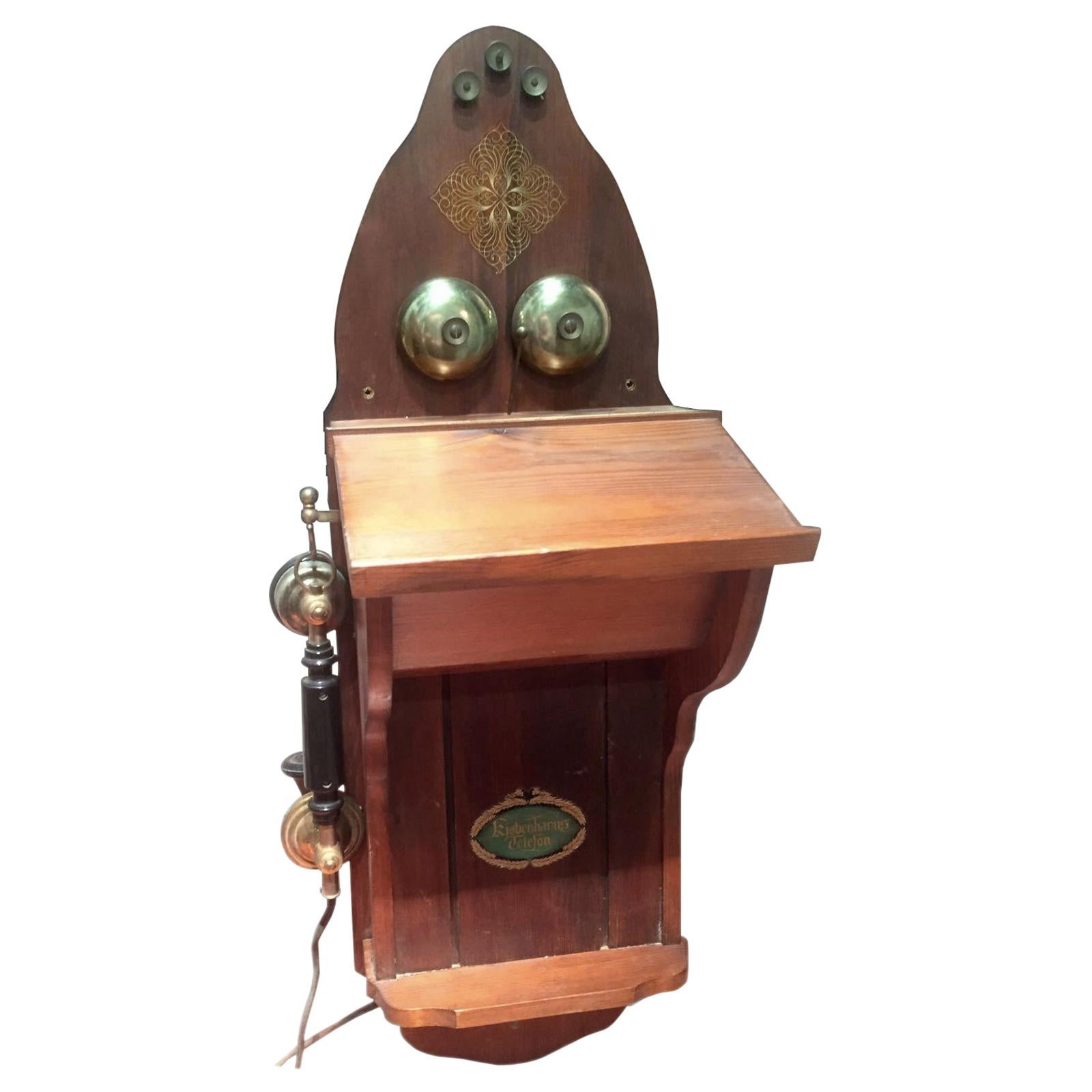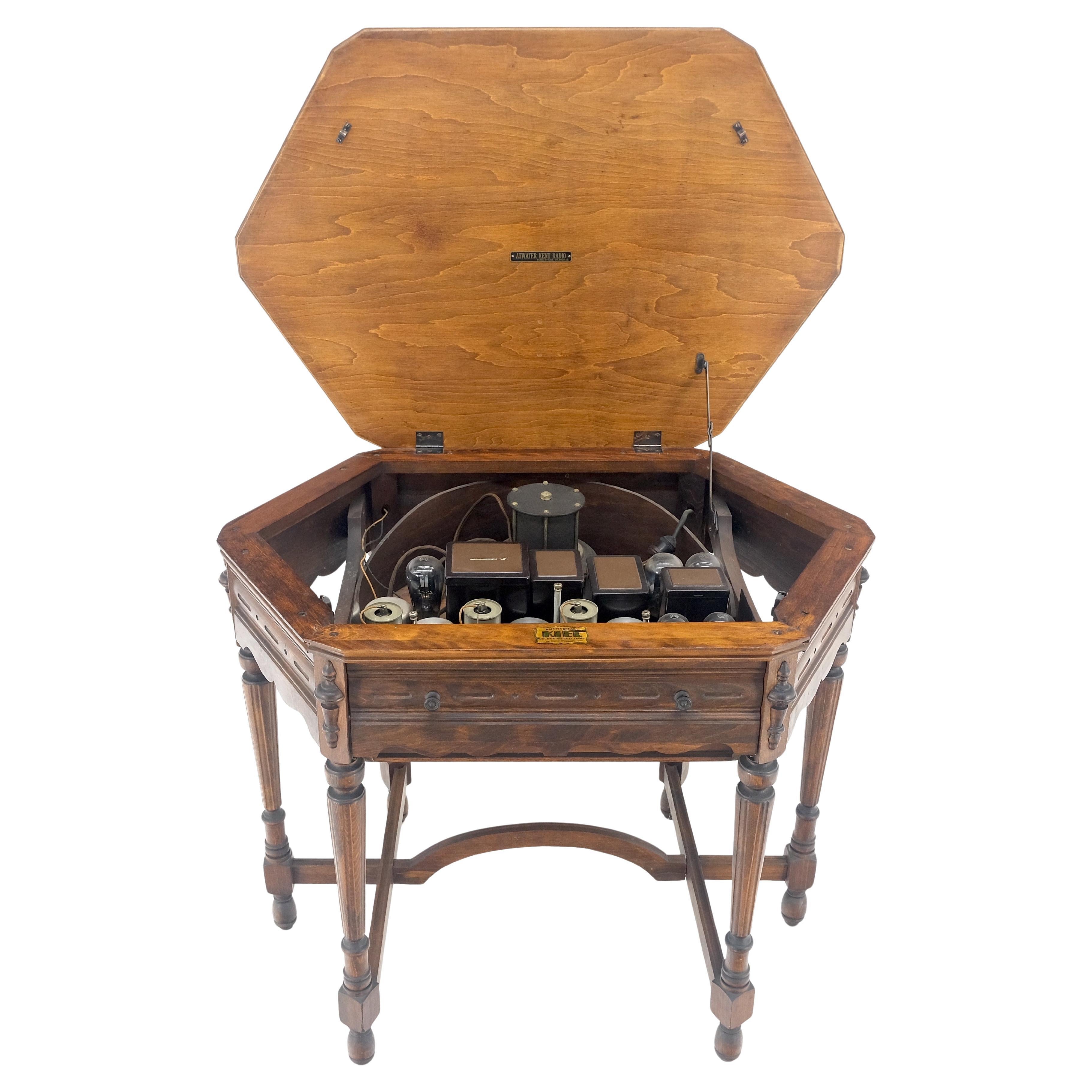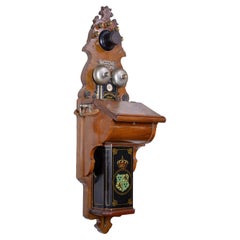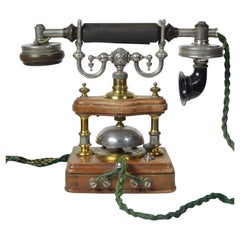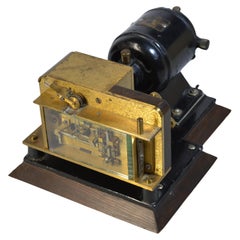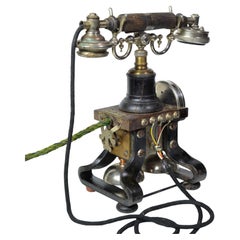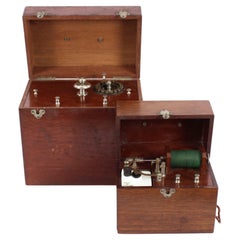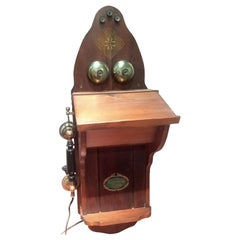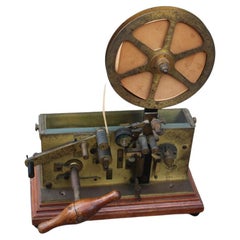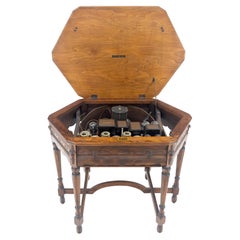Items Similar to Antique Wooden Ericsson MB 115 Crank Magneto Field Telephone 1895 С Mark 1
Want more images or videos?
Request additional images or videos from the seller
1 of 12
Antique Wooden Ericsson MB 115 Crank Magneto Field Telephone 1895 С Mark 1
$440
£335.94
€388.17
CA$617.68
A$688.47
CHF 361.21
MX$8,407.28
NOK 4,573.75
SEK 4,322.89
DKK 2,897.11
About the Item
Rare, hard to find. Telephone “C” Mark 1 (Mk 1), designed by Ericsson’s of Stockholm, was the first portable military telephone. It was used in large numbers in the South African War of 1899-1902 by the Telegraph Battalion RE and became the standard field telephone of the British Army. Field Telephone “C” Mark 1 was patented on 29th October 1895.
Size app.: 30,2 x 17 x 22 cm (roughly 11.88 x 6.69 x 8.66 in). Pretty good condition, age and usage wear, damages, losses. Please study high-res pictures for cosmetic condition! In person actual item may appear darker or brighter than in our pictures, strictly depending on sufficient light in your environment. Weight of app. 6.2 kg it is going to measure some 8 kg packed for shipment.
Alexander Graham Bell is credited with inventing the telephone in 1876. Within two years the U.S. Army began using telephones. Lieutenant A. H. Bagnold, RE, produced a drawing for a telephone in October 1877, and the Indian Army used field telephones, designed and manufactured by Lieutenant G.R.R. Savage, RE, in regimental workshops, for operations in Peshawar in December 1877. Later telephones were installed in Royal Garrison Artillery fortresses in Britain. It took some time for British officers to accept this new instrument because the early telephones were unreliable and there was no written copy of the message sent. The extensive use of telephones in the latter stages of the Boer war, however, proved their military worth. During the Boer War much use was made of the existing civilian telephones and telephone exchanges, but for field use specially designed telephones and exchanges had to be produced. The “C Mark 1” and the “D Mark 1” were the first of a whole family of field telephones to be developed for the British Army. The Telegraph Battalion’s sections laid 18,000 miles of telegraph and telephone cable during this war. A total of 13,500,000 messages were handled in 4 years and the Battalion grew in strength from 600 to 2,500 men. General French used telegraph and the telephone to direct his flank formations and they were also used on the battlefield to control artillery fire. This was the first time that the Telegraph Battalion had provided tactical as well as strategic communications for the Army. This was also the first war in which telephones were used in any number and an attempt was made by the British Army to operate wireless for the first time in a campaign, but atmospheric conditions proved unsuitable. During the last phase of the was the country was divided by a chain of blockhouses linked by telephones operated by the Telegraph Battalion. L. M. Ericsson & Co was founded in 1876, becoming a limited company in 1896. The first foreign factory was established a year later in St. Petersburg, and the first foreign office in London in 1898. The British L. M. Ericsson Mfg Co Ltd head office was at International Buidlings, 67/73 Kingsway, London WC2, with a factory subsequently set up at Beeston, Notts.
- Attributed to:L.M. Ericsson (Manufacturer)
- Dimensions:Height: 8.66 in (22 cm)Width: 11.88 in (30.18 cm)Depth: 6.69 in (17 cm)
- Style:Art Nouveau (Of the Period)
- Materials and Techniques:
- Place of Origin:
- Period:
- Date of Manufacture:e.g. 1895
- Condition:Wear consistent with age and use. Minor losses. Minor structural damages. Pretty good condition, age and usage wear, damages, losses. Please study high-res pictures for cosmetic condition! I.
- Seller Location:Sweden, SE
- Reference Number:1stDibs: LU8776241955802
About the Seller
No Reviews Yet
Vetted Professional Seller
Every seller passes strict standards for authenticity and reliability
1stDibs seller since 2023
13 sales on 1stDibs
Typical response time: 4 hours
- ShippingRetrieving quote...Shipping from: Sweden, Sweden
- Return Policy
Authenticity Guarantee
In the unlikely event there’s an issue with an item’s authenticity, contact us within 1 year for a full refund. DetailsMoney-Back Guarantee
If your item is not as described, is damaged in transit, or does not arrive, contact us within 7 days for a full refund. Details24-Hour Cancellation
You have a 24-hour grace period in which to reconsider your purchase, with no questions asked.Vetted Professional Sellers
Our world-class sellers must adhere to strict standards for service and quality, maintaining the integrity of our listings.Price-Match Guarantee
If you find that a seller listed the same item for a lower price elsewhere, we’ll match it.Trusted Global Delivery
Our best-in-class carrier network provides specialized shipping options worldwide, including custom delivery.More From This Seller
View All1891 Antique LM Ericsson Swedish Victorian Walnut Wall Telephone Crank Magneto
By L.M. Ericsson
Located in Sweden, SE
Rare antique model 1889 wall telephone by L.M. Ericsson & Co, Stockholm, Sweden. Serial #30929 was manufactured in 1891 with the last service label from 1905. Similar to model AB210,...
Category
Antique Late 19th Century Swedish Victorian Scientific Instruments
Materials
Brass, Steel, Iron
L. M. Ericsson BC 2000 Telephone Made in 1900 Designed as Old Times Book Press
By L.M. Ericsson
Located in Sweden, SE
Very rare collectible desktop telephone L. M. Ericsson model BC 2000 (Old Catalogue No. 400) for battery ringing. Exclusive and unusual design in the form of an old times book press. Framework of polished walnut. Micro-telephone RE 2002 (Old Cat. No. 520) with cord RS 7021 (Old Cat. No. 2252) and switch in the handle resting on a cradle switch, flexible cable, RS 9000 (Old Cat. No. 2084) and terminal block within Ericssons serial number that dates device on 1900 Stockholm, Sweden.
Size app.: 22.5 cm (roughly 8.9 in) high, 27 cm (roughly 10.6 in) wide, 11 cm (roughly 4.3 in) deep. Very good condition, age and usage wear plus tiny losses. Please study high-res pictures for cosmetic condition! In person actual item may appear darker or brighter than in our pictures, strictly depending on sufficient light in your environment. Weight of app. 2 kg it is going to measure some 3 kg packed for shipment.
Lars Magnus Ericsson began his association with telephones in his youth as an instrument maker. He worked for a firm which made telegraph equipment for the Swedish government agency Telegrafverket. In 1876, aged 30, he started a telegraph repair shop with help from his friend Carl Johan Andersson. The shop was in central Stockholm (No. 15 on Drottninggatan, the principal shopping street) and repaired foreign-made telephones. In 1878 Ericsson began making and selling his own telephone equipment. His phones were not technically innovative, as most of the inventions had already been made in the US. In 1878, he made an agreement to supply telephones and switchboards to Sweden's first telecom operating company, Stockholms Allmänna Telefonaktiebolag. Also in 1878, local telephone importer Numa Peterson hired Ericsson to adjust some telephones from the Bell Telephone Company. This inspired him to buy a number of Siemens telephones...
Category
Antique 1890s Art Nouveau Desk Sets
Materials
Metal, Brass
Antique Danish SNTS Morse Telegraph Register Wheatstone transmitter w motor
Located in Sweden, SE
The telegraph apparatus made in early 20th century and equipped with electric motor (Københavns Elektromotor Fabrik) perhaps later ca 1925.
The brass and steel instrument is state of the art creation by legendary Danish engineers. Very good, minimal age n usage wear, original state, very well preserved and likely functioning. Please study high-res pictures for cosmetic condition! Register serial 70868. app. 14,5 cm high (6”) 27 cm deep (11”) and 22 cm wide (9”). App. 6,2 kg weight it is going to measure some 9 kg packed for shipment.
Wheatstone type transmitter was produced by The Great Northern Telegraph Company (Det Store Nordiske Telegrafselskab A / S) that was founded in Denmark in June 1869. It was set up as a merger of three recently established telegraph companies initiated by Danish industrial mogul Carl Frederik Tietgen. The aim of the firm was to create a worldwide telegraph company. The former headquarters of the GNTC on The Bund, Shanghai. The starting point of The Great Northern Telegraph Company (now GN Store Nord) was a concession agreement, which C.F. Tietgen made with the Russian Tzar...
Category
Early 20th Century Danish Art Deco Historical Memorabilia
Materials
Brass, Stainless Steel
Antique L. M. Ericsson AC110 Iron Skeleton Telephone Taxen Eiffel Dachshund #3
By L.M. Ericsson
Located in Sweden, SE
Desktop telephone model AC 110 (Old catalogue No. 375) made by L. M. Ericsson, Stockholm in period of 1895-1910. A legendary model that enjoys special attention from collectors.
Size app.: 30 cm (roughly 11.8 in) high, 27 cm (roughly 10.6 in) wide, 14 cm (roughly 5.5 in) deep. Quite good condition, age and usage wear, attritions, damages, losses of 2 feet out of 4, original finish! Please study high-res pictures for cosmetic condition! In person actual item may appear darker or brighter than in our pictures, strictly depending on sufficient light in your environment. Weight of app. 6 kg it is going to measure some 8 kg packed for shipment.
Lars Magnus Ericsson began his association with telephones in his youth as an instrument maker. He worked for a firm which made telegraph equipment for the Swedish government agency Telegrafverket. In 1876, aged 30, he started a telegraph repair shop with help from his friend Carl Johan Andersson. The shop was in central Stockholm (No. 15 on Drottninggatan, the principal shopping street) and repaired foreign-made telephones. In 1878 Ericsson began making and selling his own telephone equipment. His phones were not technically innovative, as most of the inventions had already been made in the US. In 1878, he made an agreement to supply telephones and switchboards to Sweden's first telecom operating company, Stockholms Allmänna Telefonaktiebolag. Also in 1878, local telephone importer Numa Peterson hired Ericsson to adjust some telephones from the Bell Telephone Company. This inspired him to buy a number of Siemens telephones...
Category
Antique Late 19th Century Art Nouveau Scientific Instruments
Materials
Metal, Brass, Bronze
Antique extra bell for L.M. Ericsson telephone model RA 10/2 RA 10/2000
By L.M. Ericsson
Located in Sweden, SE
RING BELLS for alternating current, Telefon AB LM Ericsson, model RA 10/2-RA 10/2000, seen in the 1930 catalogue, 2 bells in nickel-plated brass, back piece in oak, lithographed iron...
Category
Early 20th Century Swedish Art Deco Decorative Art
Materials
Metal, Brass
Mahogany Tea Caddy Wooden Casket Box w Antique Glass Empire early 19th century
Located in Sweden, SE
Rectangular shape mahogany veneered casket made in first half of 19th century presumably in Europe. Cast glass vessels are intact at their original place. Candy sugar bowl along with...
Category
Antique Mid-19th Century Empire Decorative Boxes
Materials
Glass, Cut Glass, Mahogany
You May Also Like
Antique 2 French Electro Therapy Devices "Institut Electrotherapy" Dated 1905
Located in London, GB
Of scientific interest two French Electrotherapy devices, both wih plaques to the tops stamped "Institut Electrotherapy, 27 Rue Godot de Mauroy, Paris"
Complete with original instru...
Category
Antique Early 1900s French Scientific Instruments
Materials
Other
Kjøbenhavns Telefon Aktieselskab (KTAS) Wall Phone Scandinavia 19th-20th Century
By Kjøbenhavns Telefon Aktieselskab
Located in Madrid, ES
Kjøbenhavns Telefon Aktieselskab (KTAS) wall phone. Scandinavia, late 19th-early 20th century.
Wall phone from the company Kjøbenhavns Telefon (later known...
Category
Early 20th Century Scandinavian Other Historical Memorabilia
Materials
Other
Italian Telegraph in Solid Brass, 1880
Located in Palermo, Sicily
Italian Telegraph in solid brass, 1880.
Category
Antique 1880s Italian Art Nouveau Scientific Instruments
Materials
Brass
$3,302 Sale Price
20% Off
Antique c1920s Tube Radio Stunning American Walnut Cabinet Lift Top Table MINT
Located in Rockaway, NJ
Antique c1920s Tube Radio Stunning American Walnut Cabinet Lift Top Table MINT.
Category
20th Century American Art Deco Musical Instruments
Materials
Walnut
Fancy Antique Swedish Telephone Early 20th Century
Located in Rochester, NY
Fancy brass , black lacquer with gilded decoration. A work of art. Swedish Coat of arms on dial. . Circa 1910. Working condition. Made by L.M. Ericsson, Stockholm, Sweden.
Category
Early 20th Century Desk Sets
Materials
Brass
Antique Victorian Quartersawn Oak Hand Crank Candlestick Phone Wall Telephone
Located in Philadelphia, PA
Antique Victorian Quartersawn Oak Hand Crank Candlestick Phone Wall Telephone. Circa Early 20th Century. Measurements: 20" H x 9" W x 12" D.
Category
Early 20th Century Unknown Victorian Scientific Instruments
Materials
Oak
